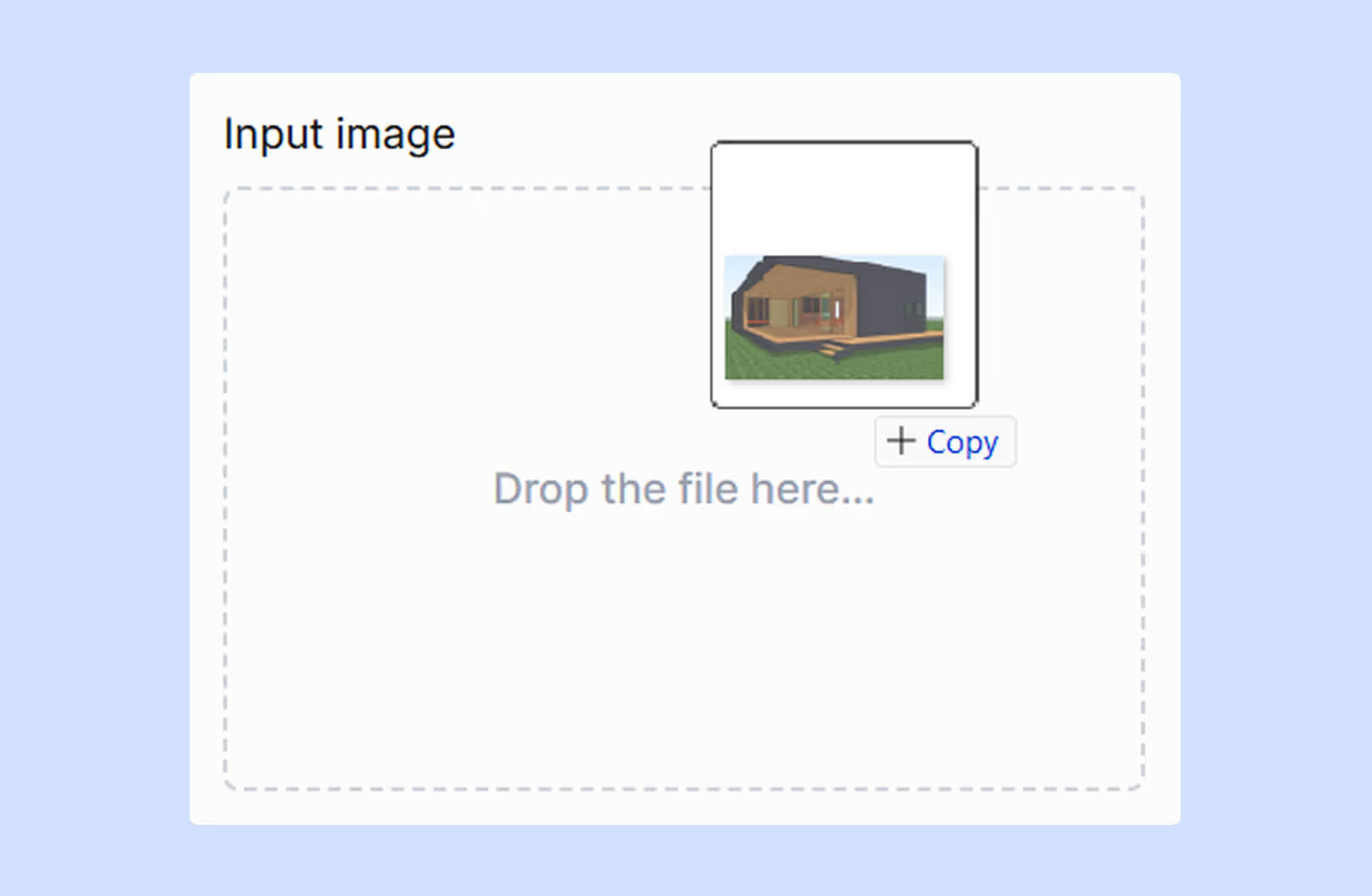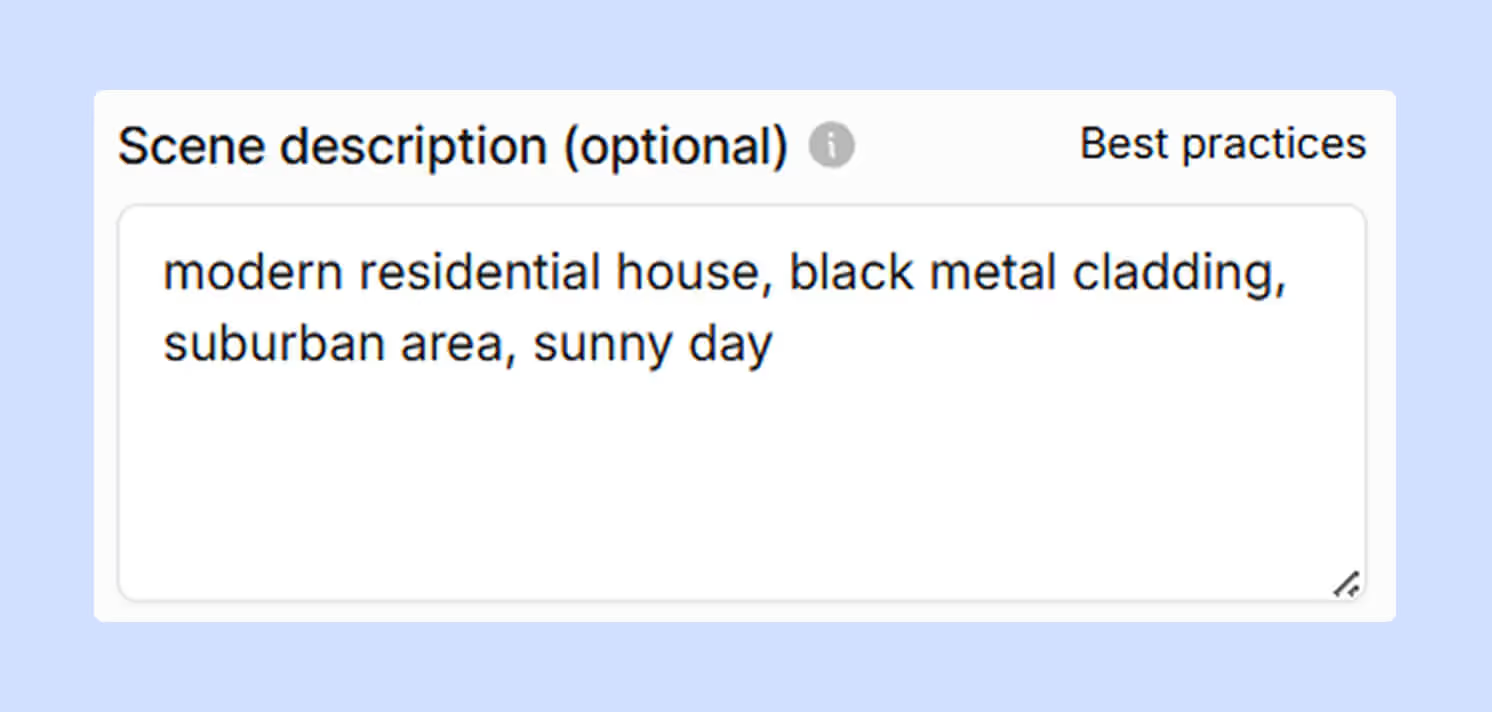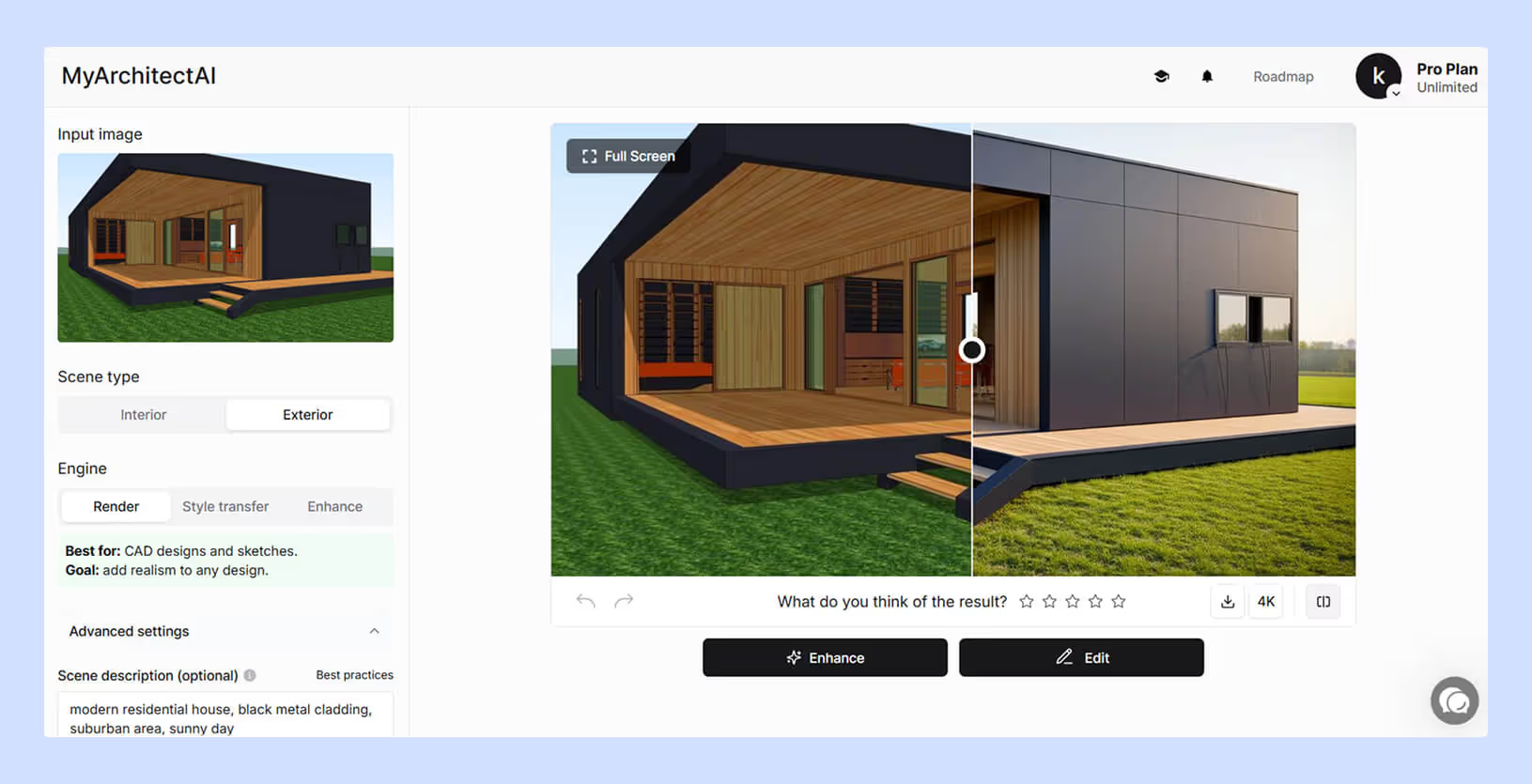Can’t decide which rendering software for Rhino to use with your architectural models? You’re not alone.
With new tools launching every year, it’s getting harder to choose a Rhino rendering program that truly fits your workflow and goals.
This guide breaks down what makes a rendering software the right fit based on what your projects need most. We’re talking about speed, realism, collaboration, and cost efficiency as the main factors.
But before we dive into these specific tools, let’s talk about the key factors your team should consider before investing time and resources in any rendering software.
When deciding which software package to use, you can’t simply rely on what’s commonly used in the industry. Sometimes the most common solution isn’t the one that will provide you with the results you’re looking for.
To make an informed choice, consider the following key factors:
1. Price
Think about how many users will need access to the software and what payment models are available. Some Rhino renderers offer monthly or annual subscriptions, while others (although rarely) provide a one-time lifetime license that can be more cost-effective in the long run.
Also, it’s important that you consider pricing per seat. Single-user licenses are usually cheaper than floating or multi-user options.
If the software supports cloud rendering, check how rendering credits work. Some plans offer limited free credits per month, while others require separate credit purchases. A low upfront cost might seem attractive, but recurring credit expenses can quickly add up.
2. Type
Rendering programs for Rhino generally falls into four main categories:
Choosing the right type depends on your workflow and what you prioritize - speed, realism, or ease of use.
3. Compatibility
Some rendering engines run directly inside Rhino as plugins, while others require exporting your model to a separate app. The latter can slow down your workflow and cause versioning headaches, so pick one that fits the way you design and collaborate.
If you're on a Mac, double-check compatibility, as many renderers still don’t fully support macOS.
4. Collaboration features
Modern design workflows are increasingly collaborative. Features that allow real-time collaboration, cloud syncing, or version control are increasingly important for many firms. If these features aren’t built-in, check whether the tool works smoothly with your existing collaboration stack, such as BIM platforms or project management tools.
5. Hardware requirements
Even the best Rhino rendering plugins won’t perform well without the right setup. Before committing, make sure your workstation meets the minimum system requirements. Traditional and real-time renderers often need powerful hardware, while AI-powered and cloud-based tools handle most of the processing remotely.
Once you have your criteria dialed in, let's create your shortlist of tools.
Best for: One-click realism
Minimum system requirements: None
Learning curve: None
Price: 10 renders for free. Then, $29/month for unlimited renders.
MyArchitectAI is an AI-powered renderer for Rhino that automates all the manual work related to lighting and texturing your scenes, producing photorealistic renders in just 10 seconds.
The tool runs in your browser, which means there are no installations needed.
Here's how it works:
1. Create a free account and upload your Rhino design.

2. (Optional) describe what the render should look like using words.

3/ Press the "generate" button. The render will be ready in about 10 seconds.

Besides producing highly realistic renders, the web-based software can also:
For example, to turn the time of day of our scene to dusk, all you need to do is write "make it dusk":

While launched only in 2023, MyArchitectAI is already being used in over 90 countries across the AEC industry, and saving users hours every day.
Best for: Real-time rendering and animated walkthroughs
Minimum system requirements: High-performance GPU
Learning curve: Moderate
Price: €999 EUR (named-user license) to €1,299 EUR (floating license) annually (full pricing breakdown)
.avif)
Lumion, released in 2010, makes the visualization process in the design phase instant without needing a complex setup. As you model in Rhino, you’ll see a rendered view real-time with Lumion’s LiveSync for Rhino plugin on an adjacent window to your Rhino workspace with a synced camera perspective.
It’s ideal for creating quick, high-quality visualizations of interiors, exteriors, and landscapes. Plus, its massive asset library that contains thousands of vegetation, people, lighting presets, and materials helps bring models to life in an instant.
Lumion needs high-end hardware to run smoothly though, so if you don't have a powerful machine, you might want to consider a lightweight alternative.
How it works: Install Lumion LiveSync for Rhino to connect your Rhino model to Lumion and see real-time renders as you progress with your design.
Best for: Fast, real-time visualization inside Rhino
Minimum system requirements: Mid-range GPU
Learning curve: Moderate
Price: €598.80 for a named license, €958 for a floating license billed annually
.avif)
Enscape is another real-time rendering software for Rhino, similar to Lumion, but each shines in different contexts.
The tool was released in 2015 by Chaos Group and is marketed as a software optimized for speed and ease. It is an ideal tool when you want instant feedback directly inside Rhino. This is suitable for doing design reviews, live presentations, or when you’re adjusting and comparing lighting, materials, or furniture during the design process. It’s also a great choice for teams that value time efficiency and teamwork, given its advanced collaboration features.
Unlike many other CGI tools on this list, Enscape is fully compatible with Mac devices.
How it works: Install Enscape for Rhino. Render your scene in real time in the Enscape window while making adjustments on your design directly in Rhino.
Best for: Highest photorealism, production-quality renders
Minimum system requirements: High-performance CPU/GPU
Learning curve: Very steep
Price: starts at $514.80/year or $84.90/month (detailed pricing breakdown here)
.avif)
V-Ray for Rhino is one of the most powerful rendering engines out there if you’re looking for high-quality and photorealistic visualizations that you can produce directly inside Rhino.
It’s used for final concept renders, marketing materials, but it can also be used for quick presentations. It is quite versatile thanks to its highly customizable render settings.
This rendering software was released back in 1997 by Chaos Group and has since established itself as an industry-standard when it comes to producing professional-grade renders.
One more thing that makes it versatile is that it supports both CPU and GPU rendering, giving users the flexibility to choose between faster speeds or higher quality, depending on their hardware.
To add to this, V-Ray also includes a library of over 21,000 assets, including materials, textures, vegetation, accessories, people, furniture, and HDRI skies.
How it works: Install V-Ray for Rhino, then apply V-Ray render elements into your Rhino model (materials, textures, lighting) to finally render directly within Rhino.
Best for: Seamless, built-in rendering in Rhino
Minimum system requirements: Standard workstation GPU
Learning curve: Easy
Price: Included with Rhino
.avif)
Cycles is the native rendering engine for Rhino, fully integrated into its Rendered and Raytraced viewport modes.
If you prefer a seamless experience without dealing with plugin installations or constant exports, switching tabs, and whatnot, Cycles is a strong choice. Everything runs directly inside Rhino.
We’re including it in this list because, while Rhino has long been a popular modeling tool, not everyone knows it now comes with a capable built-in, physically-based renderer. Earlier versions only offered a basic rendering engine with limited lighting and texture control, which received mixed feedback from users.
Starting with Rhino 7 (2020), the built-in Rhino Render began using the Cycles engine, developed by the popular Blender Foundation. While it’s not as feature-rich as advanced tools like V-Ray or Lumion, Cycles offers an impressive balance of speed, quality, and simplicity. It’s ideal for users who want a reliable rendering tool without the extra setup or cost.
How it works: In Rhino, under the Render menu, switch to the Rhino Render engine powered by Cycles. You can also switch your viewport to “Raytraced” mode to enable real-time rendering with Cycles. Read our detailed guide on how to render in Rhino with 3 different methods.
Best for: Fast, photorealistic renders
Minimum system requirements: 4 GB RAM, quad-core CPU, Intel/AMD 64-bit processor
Learning curve: Moderate
Price: $99 USD per month or $1,118 USD annually
.avif)
KeyShot is a real-time renderer known for its intuitive interface, making it accessible for users without a traditional rendering background.
It has a unique drag-and-drop functionality that lets you quickly apply materials, textures and lighting while real-time ray tracing ensures high-quality visuals for presentations and client reviews.
For custom workflows, its advanced material editor supports texture layering, procedural geometry and fine-tuned lighting setups. Realistic camera controls further enhance photorealistic outputs, giving designers complete control over their final visualizations.
How it works: Install the KeyShot plugin for Rhino. Then, use its LiveLinking feature to send your model directly to the KeyShot software. As you refine your model in Rhino, it updates the model in KeyShot. Render settings are retained through changes made.
Best for: Real-time rendering and quick animations
Minimum system requirements: Raytracing-ready GPU (full specs here)
Learning curve: Minimal
Price: Comes with a free Community version. $360 USD (Pro, single user), $708 USD (Team, per seat) annually
.avif)
Only released in 2020, D5 Render has already established itself as one of the most popular real-time rendering choices in the architecture and design industry.
It’s preferred by architects who want a balance of speed, realism, and simplicity. It delivers near photorealistic results without the steep learning curve or the heavy setup time typical of traditional rendering tools.
It is highly compatible and can be integrated with major CAD software like Rhino, Sketchup, 3ds Max, and Revit, among others. Like Lumion, it also has a similar LiveSync functionality that automatically adjusts to changes made in the connected modeling software.
What makes it stand out from its competition is its adoption of advanced AI technology that speeds up material creation, landscaping, and post-processing within the software. And, despite all the features it has, it still remains an intuitive tool to use thanks to its simple and familiar interface.
Note: D5 Render doesn't support macOS (except for some workarounds).
How it works: Install the D5 Converter, which will appear as a toolbar in Rhino. Then, sync your Rhino model to D5 before you apply D5 materials. Finally, render your scene.
At the end of the day, the best Rhino architecture rendering tool isn’t the most popular or what’s commonly used. It’s about finding the program that aligns with your firm’s workflow, goals, and most importantly, resources such as budget, hardware, time, and team expertise.
If your priority is speed and ease of use, pick an AI renderer like MyArchitectAI
If you need more control and interactive walkthroughs, choose Lumion, Enscape, or D5 Render.
If you're on a budget, go with Cycles, as it's already included with Rhino.